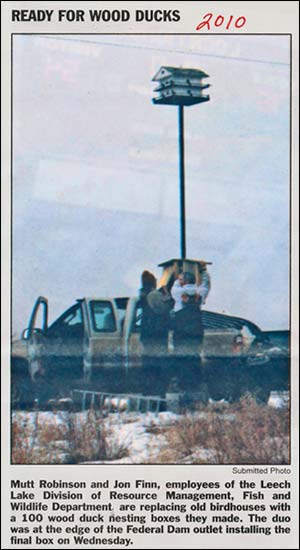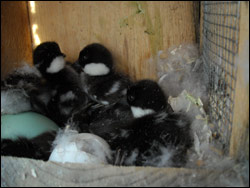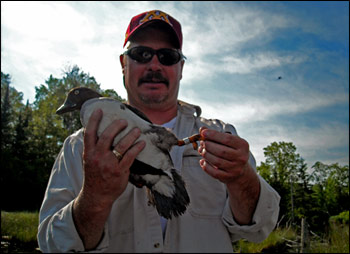Wildlife Habitat Enhancement Program
 The wildlife program has undertaken, and participated in, many habitat enhancement programs over the years. These activities are frequently used as a means of providing or improving habitats that are in short supply due to human impacts to the environment.
The wildlife program has undertaken, and participated in, many habitat enhancement programs over the years. These activities are frequently used as a means of providing or improving habitats that are in short supply due to human impacts to the environment.
Prescribed burning
Historically fires were common in the lowland sedge meadows that are found along many of our lakes and major rivers, as well in the dry upland pine forest. In the case of sedge meadows these fires kept these areas open and provided nesting cover for species that utilize these habitats. In the upland pine forests fire promoted the regeneration of pine species and kept these areas from being taken over by hardwood species. Although is it difficult to put fire back onto the landscape to the degree it historically occurred, we conduct fires in situations where it is safe and will benefit these habitats and the species that need them.
Impoundments
We have worked cooperatively with the Chippewa National Forest in the management of many of the impoundments that are located on the reservation. Most of these impoundments were built to provide habitat for waterfowl and other species that need open water wetlands. Some are also utilized for bait harvest. This work includes general maintenance and management, draw downs to promote wetland vegetation, There is an ongoing evaluation of the value of these areas of wildlife.
Nest boxes
 |
 |
The wildlife program has for may years been constructing, installing, and maintaining nest boxes, primarily for waterfowl like woodducks, common goldeneyes, and hooded mergansers. Due to extensive timber harvest, that has occurred in this area, most trees never get large enough to develop cavities in them. As a consequence there is a shortage of nesting cavities for many species that use them. Providing artificial nest boxes is a way of lessening this loss until such time as forest management practices can be improved so they can accommodate this need. (photos above by Jon Finn)
Winnie Ponds Fish and Wildlife Management Area
The Winnie Ponds Fish and Wildlife Management Area was constructed in the 1950s by the Minnesota Department of Natural Resources to rear walleye fingerlings. The large ponds proved to be difficult to manage for this purpose and operations ceased in the 1970s. Legislation passed by the State of Minnesota allowed the area to revert back to the Band and we start managing the area in the 1990s. The Band’s Fisheries Program subdivided one of the ponds into smaller, more manageable ponds that are used to rear fish, while the remainder is used for wildlife management, primarily waterfowl. There is also an interpretative trail on the site and an observation platform.
Common tern nesting habitat
One of the last four remaining colonies of common terns in Minnesota, nest on tribal lands out in the middle of Leech Lake. This is a species that has declined dramatically due to predation, human disturbance, and competition with other colonial waterbirds. In an effort to prevent the loss of this colony and to enhance their reproductive success the reservation has constructed several new nest sites on the islands for terns and protects these sites from other colonial waterbirds like gull and cormorants in addition to controlling predators.
Wildlife population monitoring

The Wildlife Program conducts, or participates in, a number of wildlife population monitoring efforts to assure that wildlife populations are healthy and not being over exploited.
Scent post survey
Scent post surveys are conducted by may agencies and individuals across Minnesota and compiled by the Minnesota DNR. This survey involves constructing as circular area of fine soil material where animal tracks can be easily identified. A strong smelling scent table is placed to the center of each circle to attract animals. By identifying what species of animals have visited the circles an index of their abundance and population trend can be developed.
Winter track survey
The winter track survey is another survey used to track the population levels and distribution of mammalian predators. It focuses on predators like fisher, pine martin, gray wolf and other predators that range over large areas in their search for food. This survey is conduced by identifying the type and number of animals by their tracks. It is conducted after a fresh snowfall along predetermined survey routes on an annual basis.
Small mammal survey
The small mammal survey was developed and is coordinated by the 1854 Authority and has many of the same cooperators as other surveys that need to be conducted over a very large scale to provide meaningful results. This survey involves the capture and identification of small mammals, including voles, mice, and shrews, over several girded parcels on the reservation. You might ask why we are interested in the diversity and number of small mammals, but they are an overall measure of the health of the environment and gives us a measure of food supple for larger predators.
White-tailed deer
White-tailed deer are a species that was once uncommon on the reservation. Forest fragmentation from logging and human development has resulted in an abundance of habitat, while climate change has lessoned the severity of our winter. These factors have resulted in large numbers of deer now calling the reservation home. If you are a deer hunter this might be a good think, if you want to gather traditional or medicinal plant, these items are hard to find due to heavy brows by deer.
The main way of tracking deer numbers is by monitoring harvest by hunters and tracking the severity of the winter. The Wildlife Program monitors tribal deer harvest and coordinates with the Minnesota DNR in the setting of State and Tribal seasons and bag limits.
Ruffed grouse survey
The ruffed grouse survey is conducted early in the spring by listening for drumming males along predetermined routes. By comparing the numbers of drumming males from year to year you can get a rough estimate of population levels across the landscape. This survey is also coordinated with other resource management agencies in order to say much about grouse populations on a broader scale.
Rare species
Although the habitat for wildlife on the reservation for many species is good, when compared to other parts of the country, we have, and continue to experience, losses to our wildlife populations. There are currently about 80 species of plants and animals that are considered sensitive, threatened, or endangered on the reservation. A current list of these species can be found at ??? In addition, one species, the passenger pigeon, is extinct, and the eastern cougar, elk, caribou, moose, plains bison, grizzly bear, and sharp-tailed grouse have all been extirpated from the reservation. Several other species including the gray wolf, trumpeter swan, pine marten, and fisher were extirpated from the reservation, but due to protection from excessive harvest have returned.
To a large degree, wildlife populations are dependant on having the proper type of habitat in adequate amounts for a species to prosper. In the modern world, meeting these demands for all species is becoming increasingly difficult. Loss of wildlife habitat due to human development and timber harvest are big factors, but climate change and the introduction on non-native species are becoming bigger issues.
Contact Us
DRM (218) 335-7400
| Name | Title | Phone |
| Mortensen, Steve | Fish, Wildlife & Plant Resources Program Director | 335-7421 |
| Finn, Jon | Fish & Wildlife Field Specialist | 335-7424 |
| White, Gary | Assistant Hatchery Manager | 335-7424 |
| Robinson, Martin | Fish and Wildlife Technician | 335-7424 |















 Division of Resource Management
Division of Resource Management